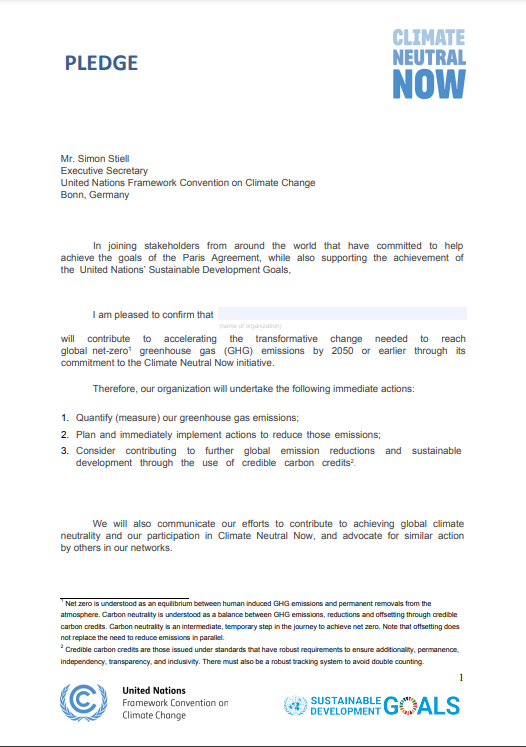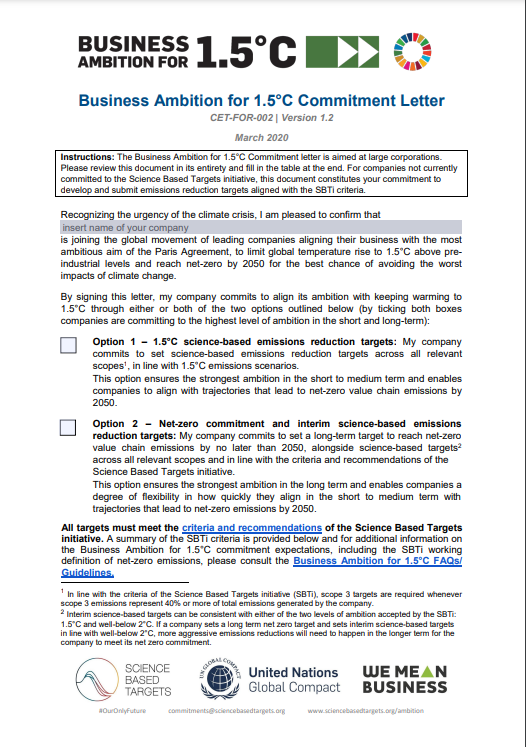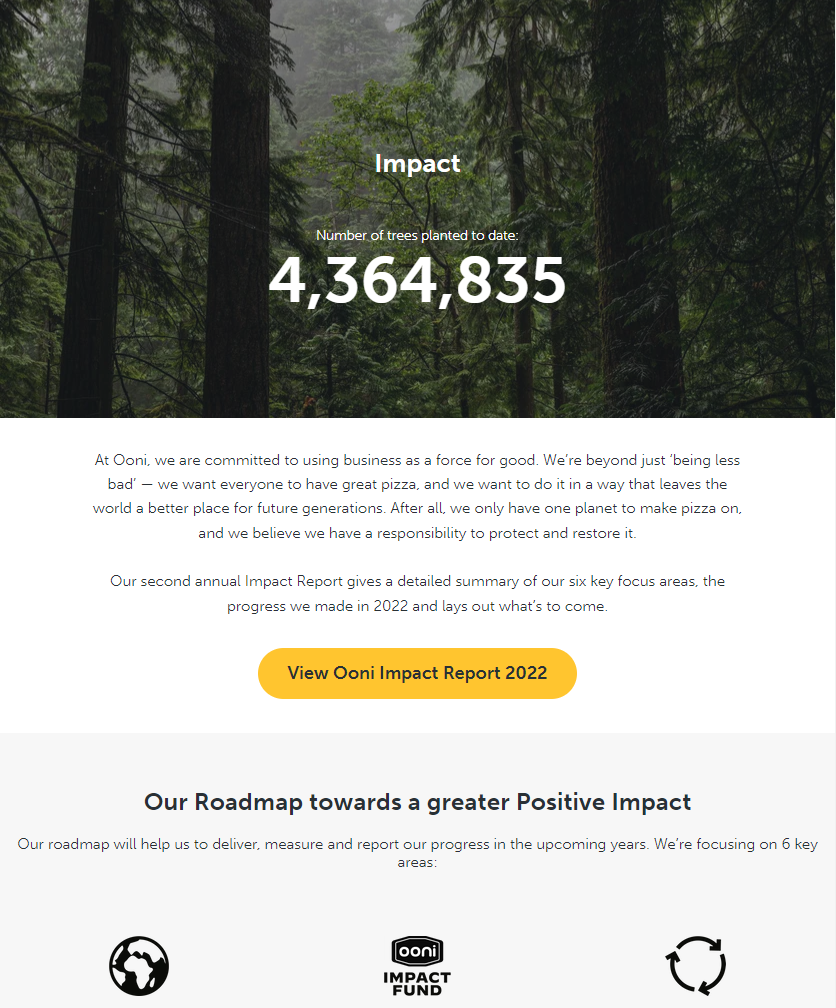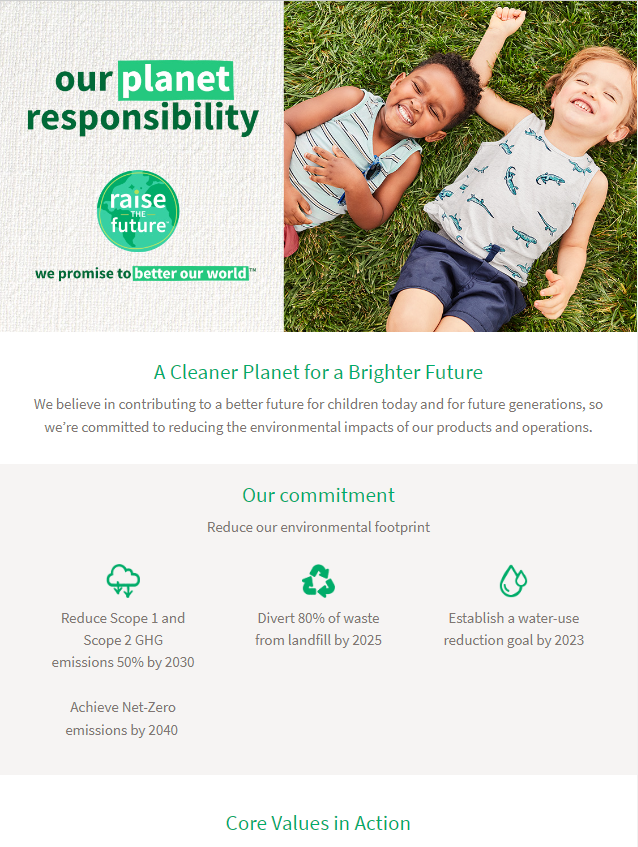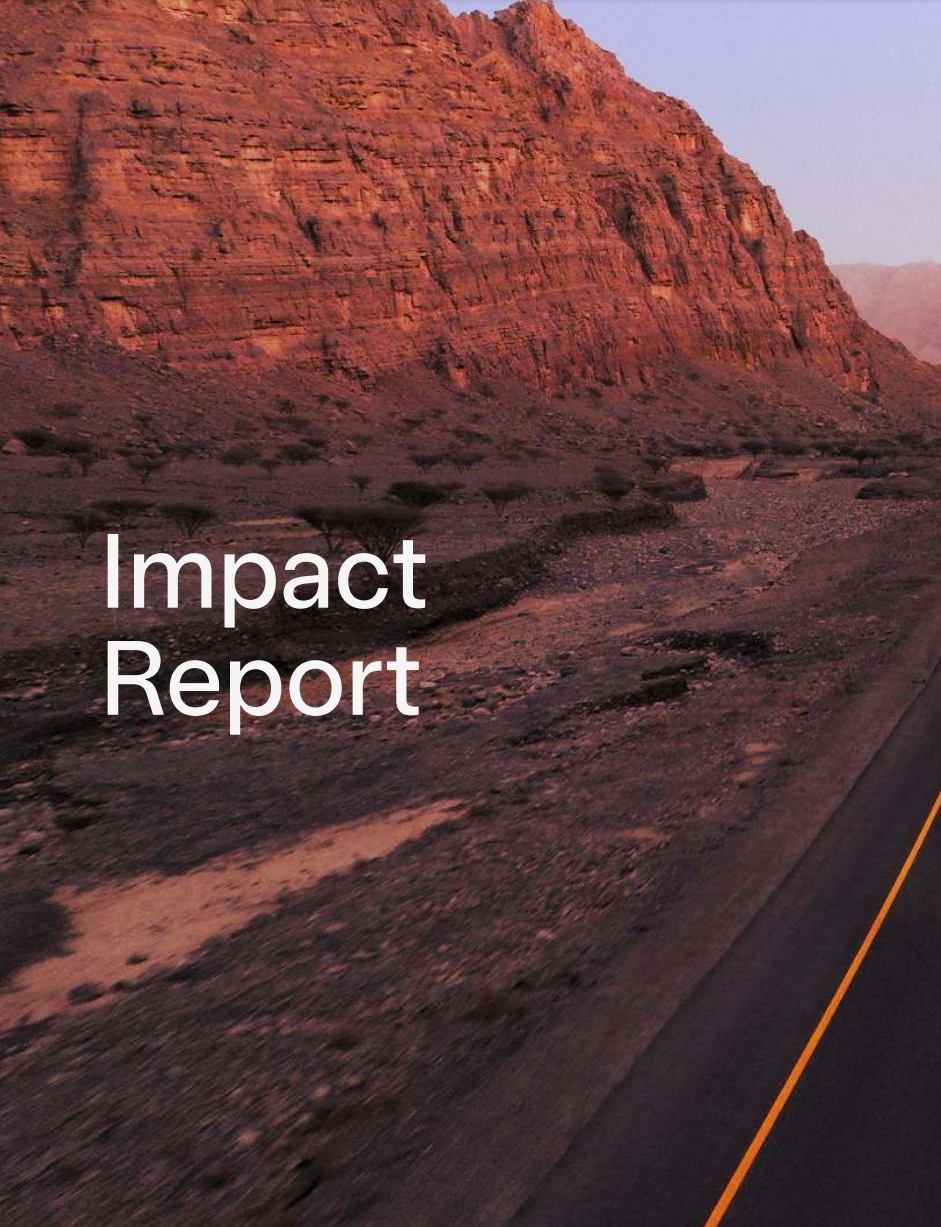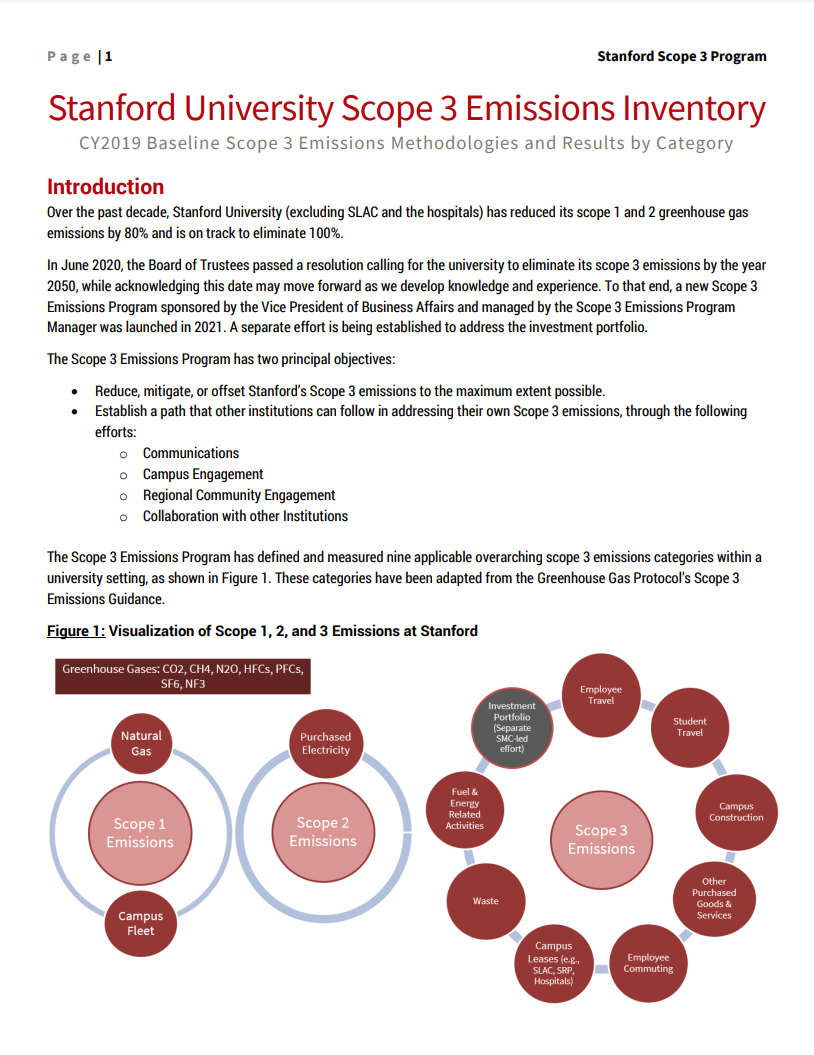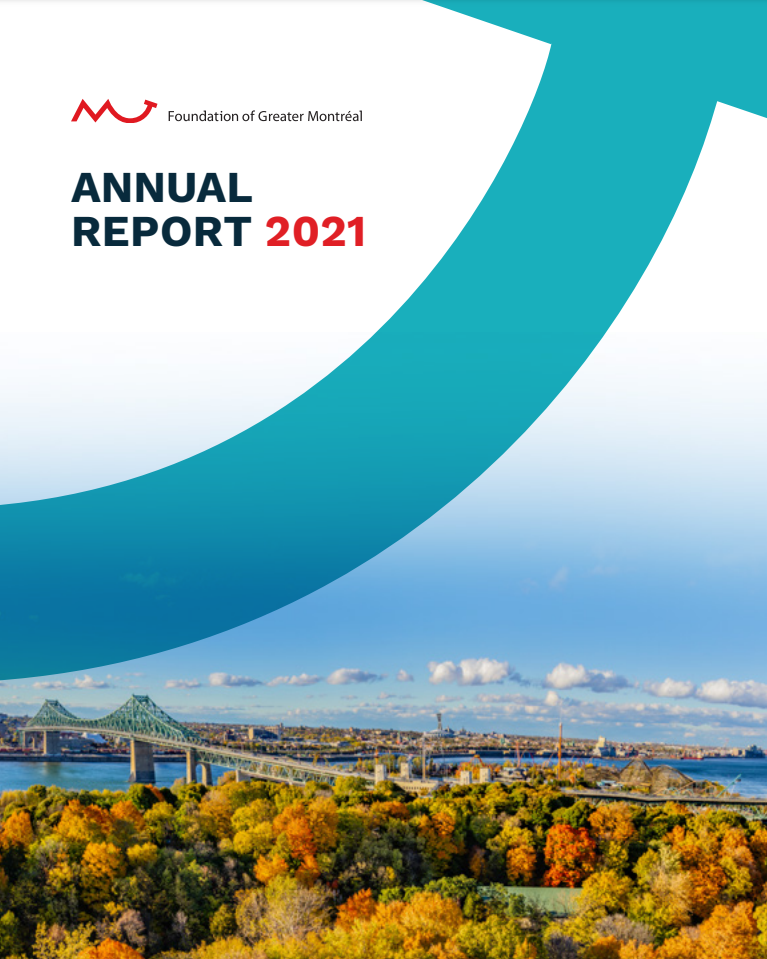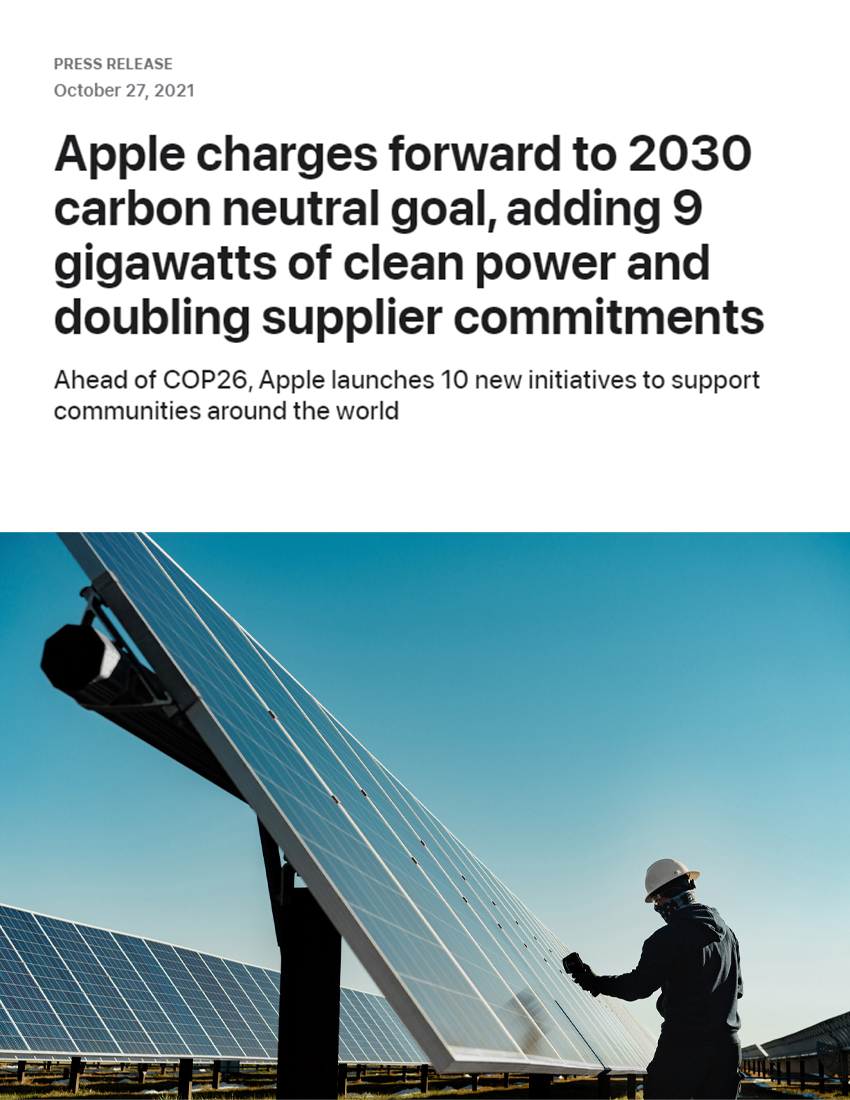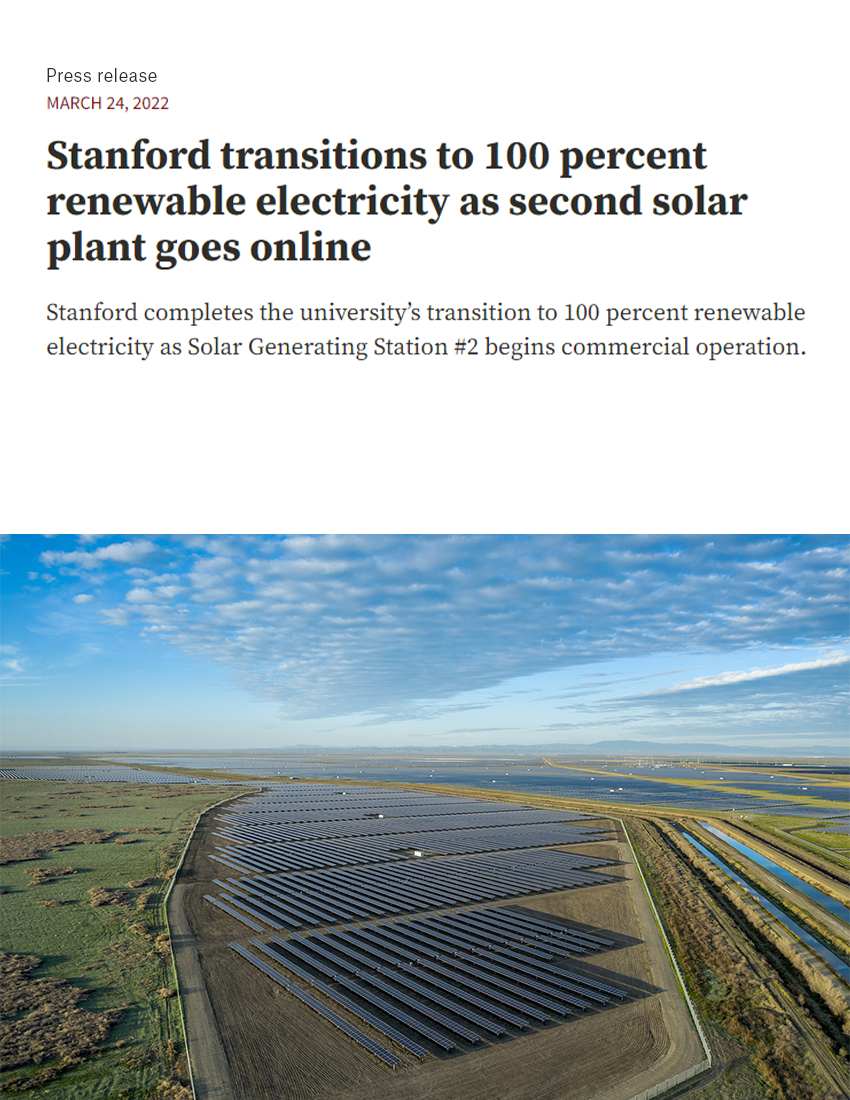The Net Zero journey
The complete process to becoming a net zero company

What is net zero?
Net zero definition
Net zero refers to the balance between how much greenhouse gas (GHG) is produced and how much is removed from the atmosphere. When we achieve a balance (where the amount we add is no more than the amount taken away), then we can say we’ve reached net zero.
It’s important to note that net zero is more than just a scientific concept or a theoretical target. It’s a universal frame of reference that provides structure and understanding to the fight against climate change, as it follows the goals and processes set forth by the Paris Agreement.

Over 80 countries, representing more than 70% of global emissions, have set net zero targets, including the world’s largest emitters: China, the US, the EU, and India.
Net zero origins
Under the Paris Agreement, signed by 196 nations in 2015, countries collectively agreed to reduce their emissions with the goal to prevent global temperatures from increasing above 2°C (and preferably capping it at 1.5°C) compared to pre-industrial levels. To keep the nations on-track towards this goal, every five years each participating nation submits a Nationally Determined Contribution (NDC), a national climate action plan that includes GHG emissions reduction targets.
In 2018, spurred by the Intergovernmental Panel on Climate Change’s (IPCC) report on stopping 1.5°C of warming, the UN climate science panel declared that, to avoid the consequences of a 1.5°C and higher future, global CO2 emissions must decrease by around 45% by 2030, and to net zero by 2050. This helped spur countries to set goals of net zero emissions by 2050.
Ultimately, the Paris Agreement hinges on countries being transparent about monitoring, verifying, and reporting their NDC implementation progress. This has spawned many laws, policies, and regulations that work to encourage companies to track, disclose, and reduce their emissions.
Carbon neutral vs net zero
Both net zero and carbon neutrality have the same goal: to balance out GHG emissions and prevent them from contributing to climate change.
However, where net zero refers to the balance between the amount of GHGs produced and the amount removed from the atmosphere, carbon neutral refers specifically to the balance between carbon dioxide (CO2) emissions and removal.
Additionally, where carbon neutral claims generally only cover carbon emissions, often include offsets, and can refer to a specific product or service, net zero typically includes all GHG reductions and removals and encompasses the whole organization’s supply chain.
What is the "net" in net zero?
As opposed to achieving zero emissions (where absolutely no GHGs are released into the atmosphere), achieving net zero emissions means that some GHGs are still inevitably released (“gross emissions”), but these emissions are offset by removing the equivalent amount of GHGs from the atmosphere and permanently capturing them (thereby achieving “negative emissions”) through anthropogenic removals or by carbon trading. So, in accounting terms, net zero emissions would equal gross emissions minus negative emissions (or, more simply, your remaining emissions minus those you’ve captured or traded).
Reaching net zero (as opposed to zero) emissions is generally considered a more achievable goal.
Global net zero strategy
Reaching net zero is crucial for ensuring that global temperatures don’t exceed the thresholds set by the Paris Agreement. By reaching net zero emissions, we can help mitigate the worst impacts of climate change and build a more sustainable planet. However, our GHG emissions, which continue to climb, need to be reduced by at least 45% by 2030 if we want to reach net zero by 2050.

The net zero timeline
Despite massive leaps in climate action, we are progressing too slowly towards the goal of keeping temperatures from rising above 1.5°C. Indeed, according to a World Resources Institute report, to reach this goal, countries will have to dramatically accelerate their efforts towards a net zero emissions future across all sectors. For instance, we’ll need to both accelerate the phasing out of coal in electricity generation (replacing it with renewables) and our afforestation and reforestation efforts by more than five times if we want to achieve our net zero goals by 2050.
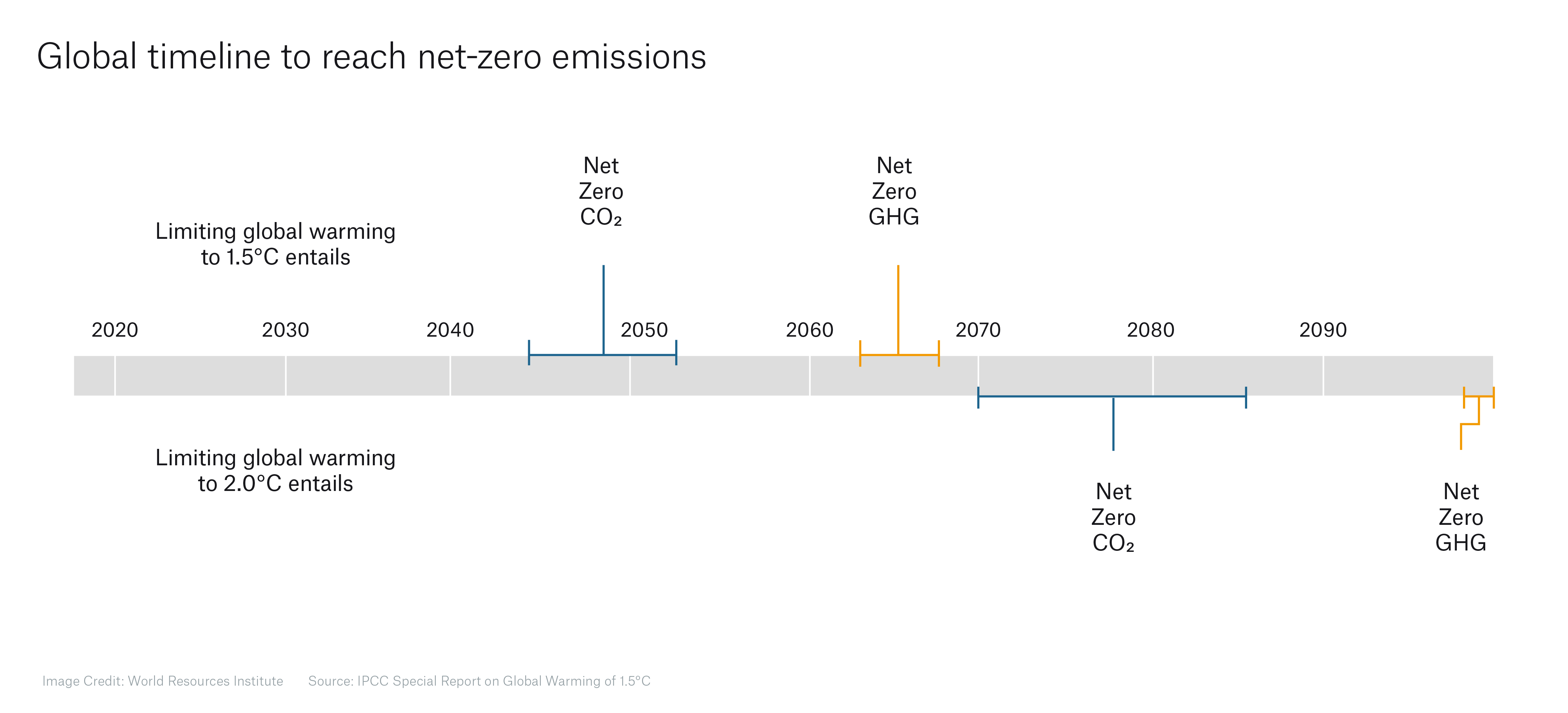
For the US to achieve net zero, they would have to reduce their net emissions by an average of 0.2 gigatons of CO2. equivalent (as much as 25,192,597 homes' annual energy use) per year over the next 30 years. If they were to achieve this goal, it would reduce global greenhouse gas emissions by about 10%.
Requirements to reach net zero
Reaching net zero will require rapid and widespread changes in policy and investment across all sectors as well as active participation by governments, industries, and individuals. It will take absolute commitment, but scientists say it can still be done.
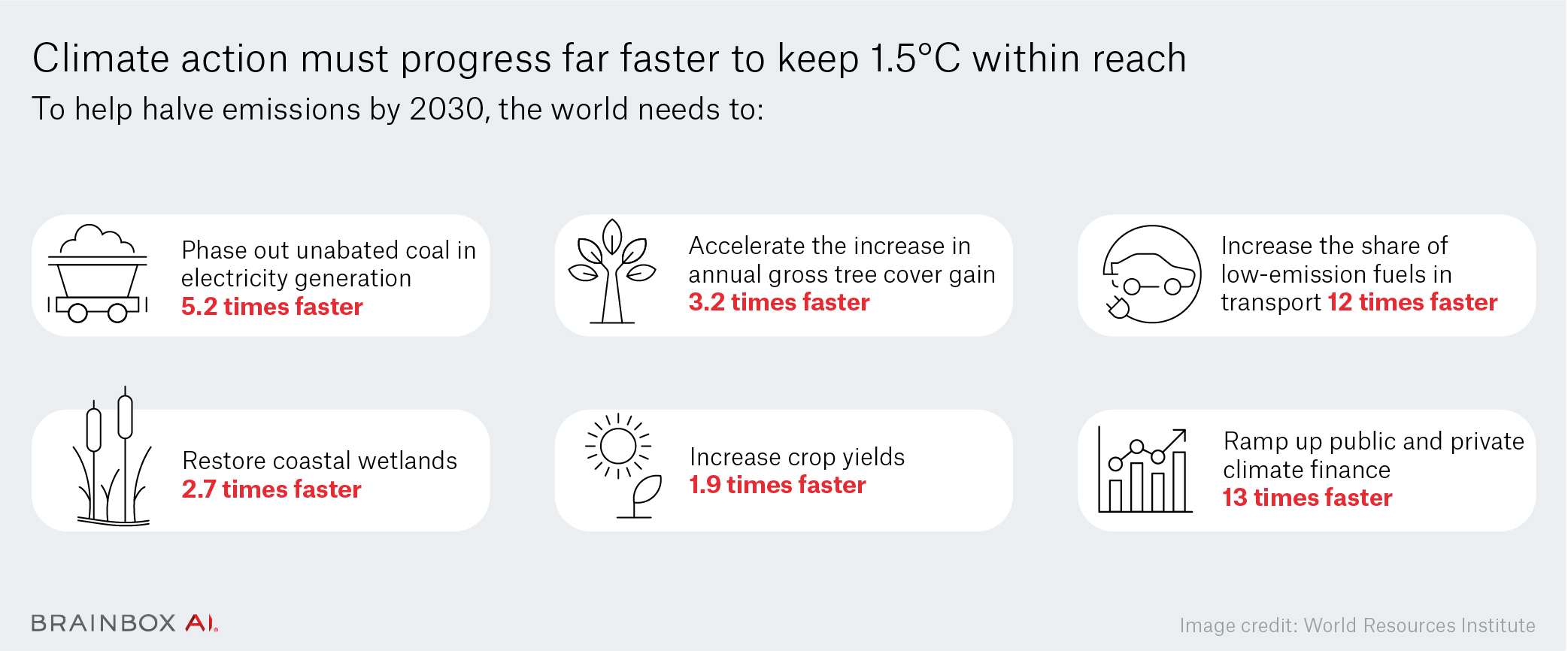
Net zero isn’t just a fad. It’s a driving force for climate action.
Net zero strategies: 3 ways to have an impact
To achieve our net zero goal, we’ll need to make a conscious effort to:
- Reduce emissions: The first move towards net zero is to collectively and dramatically reduce our GHG emissions. This starts with relying less on burning fossil fuels by focusing more on things like investing in renewables, fuel switching, improving the efficiency of food production, and reducing waste.
- Restore our environment: After reducing our emissions as much as possible, we can turn to offsetting, supporting restoration projects and initiatives that help prevent deforestation and encourage the natural absorption of CO2 performed by plants and trees.
- Remove excess CO2: The IPCC has made it clear that limiting global warming to below 1.5˚C will not be achievable without direct air carbon capture and storage (CSS) technology. This technology is costly and still evolving, though it’s currently being trialled by some major organizations.
Today, there are a growing number of policies and regulations aimed at reducing emissions and protecting and restoring our environment. Moreover, over a third of the world’s largest publicly traded companies have committed to net zero targets. Still, issues of actual emissions reductions remain due to a lack of knowledge, incentives, and standardized reporting.
According to Net Zero Tracker, more than a third (702) of the world’s largest publicly traded companies have net zero targets. However, 65% of these companies’ corporate targets don’t yet meet minimum procedural reporting standards.
Becoming a net zero company
Businesses can play a crucial role in achieving net zero by systematically reducing their GHG emissions each year, offsetting any remaining emissions, and reporting on their progress. To do so effectively, businesses should go through a series of steps that include emissions mapping, target setting, drawing up net zero plans, strategy implementation, and the communication of progress and successes.
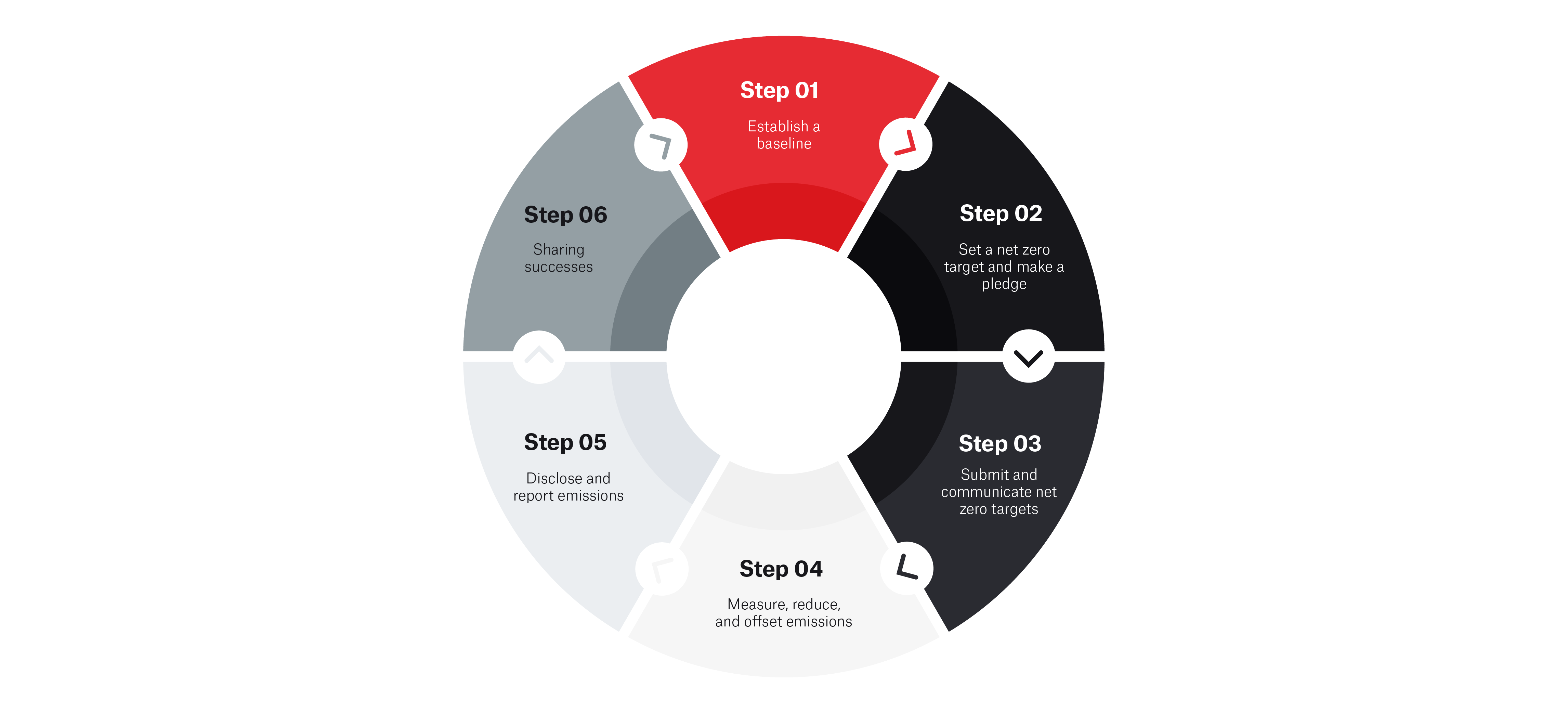
Step 1: Establish a baseline
A baseline is the primary starting point for emissions sourcing, calculation, target-setting, tracking, progress measurement, and reporting. It provides a snapshot of an organization's GHG emissions in a moment in time (generally the year for which a company has reliable and/or comprehensive emissions data), acting as a yardstick for measuring all future emissions reduction progress.
To calculate its baseline, a company needs to look at its scope 1, 2, and 3 activities, collect data on them, and then calculate them. This process of understanding where your emissions are stemming from and what their environmental impacts are is crucial for developing effective targets and strategies to reduce and mitigate emissions.
For more information on how to calculate your baseline, check out our article on how to go about calculating your baseline.
Step 2: Set a net zero target and make a pledge
Setting a net zero target is key to achieving emissions reduction goals. It not only adheres to emissions regulations but also increases transparency, both internally and externally. Plus, it provides a tangible goal that an organization can work towards.
Net zero targets should be accompanied by a science-based target aligned to limiting global warming to 2°C or, more preferably, 1.5°C. The Science Based Targets initiative (SBTi) offers indispensable guidance on setting such a target, providing a clearly-defined pathway for emissions reductions while maintaining future-proof growth.
Why set a net zero target?
There are plenty of reasons to set and work towards a net zero target. Aside from the obvious climactic benefits, setting a target makes good business sense.
Why setting net zero targets is good for business:
- It sharpens a company’s competitive edge: As new policies are passed and more businesses declare their net zero goals, businesses without targets are finding they’re being left behind, as customers, investors, or employees are increasingly prioritizing sustainability and governments are increasingly demanding stricter compliance.
- It increases investor confidence: Increasingly, financial institutions are factoring carbon reduction efforts into their investment decisions. A company that has a credible commitment to net zero is a more attractive investment opportunity.
- It reduces costs: Reducing energy consumption means lower energy costs.
- It helps mitigate future risks: Businesses can enhance their resilience to future emissions regulations by setting net zero goals now.
According to McKinsey, sustainability reduces costs and can improve operating profits by up to 60%.
Setting a net zero target date
Setting a target date for net zero emissions is an important step on the path to net zero. The SBTi draft criteria states that the net zero target year should be no later than 2050, but some companies choose target years closer to 2030. While the ambition to move the goalposts forward is admirable, companies should evaluate whether their accelerated aims are attainable. They should also consider the potential financial implications involved in such a near-term goal.
To demonstrate their commitment, companies can have their targets validated by the SBTi’s Net Zero Standard.
Making a pledge
Businesses can make a pledge on their website, in the media, in their sustainability reports, and/or on a third-party website such as the United Nations Framework Convention on Climate Change’s (UNFCCC’s) Race to Net Zero, Business Ambition for 1.5 C - Our Only Future, Business Declares, The Climate Pledge, Exponential Roadmap Initiative, Planet Mark, and the SBTi. Small and medium-sized enterprises can also make their pledges on SME Climate Hub.
Making a pledge indicates companies mean business when it comes to meeting their net zero goals. By pledging through a reputable website, like the ones listed above, businesses will be held to specific target standards in addition to being featured as a committed company on the pledge website. This adds credibility to a company’s pledge and signals to shareholders and the public that they take their commitment seriously.
90% of executives believe sustainability is important, but only 60% of organizations have sustainability strategies.
Looking for inspiration? Check out these pledge examples:
Setting interim targets
Ambitious net zero goals alone are not sufficient to reach net zero. In addition to setting a target, companies also need to make proactive changes along the way. Deciding on realistic, near- and medium-term emissions reduction milestones can support the transition to net zero and could help make the overall net zero goal less overwhelming and more achievable.
Indeed, the Task Force on Climate-Related Financial Disclosures (TCFD) recommends that all organizations have five- or 10-year interim targets. This is in line with the Paris Agreement, which requires participating countries to submit emissions-reduction plans every five years.
The great thing about interim targets is that they break the sources of business emissions into manageable sections. These sections can have their own targets which all work towards achieving a final net zero target. An example of an interim target could include focusing on decreasing the emissions of the highest polluters in a company’s portfolio or addressing the emissions of different sectors within a company, like manufacturing, utilities, or transportation.
Interim targets not only help companies calibrate their GHG emissions to ensure they’re on track to achieving their net zero targets, but reporting them to investors can also foster trust and transparency. To find out more about how to set short-term emissions reduction targets, you can check out the SBTi’s comprehensive how-to guide for near-term target setting.
Punctuate your road to net zero with credible signposts at various intervals to help guide you towards your goal and encourage accountability.
Step 3: Submit and communicate net zero targets
Once targets have been set, a company can submit its plans for validation to the SBTi. There, a team of technical experts will review the submission, validate it against their science-based criteria, and communicate their decision with added in-depth feedback. After a target has been approved, the SBTi will publish it on its companies taking action page and partner websites, which bolsters a company’s credibility and helps avoid greenwashing.
Having a company’s goals validated by the SBTi is a good way to know whether its short-, medium-, and long-term net zero targets are feasible. It also boosts emissions transparency and can reinforce trust with its stakeholders. Additionally, by participating in SBTi validation, businesses will be helping to create standardized definitions and frameworks for net zero targets and emissions reductions.
To get started, businesses can take advantage of the SBTi’s numerous resources that help guide companies through the target-setting and submission process.
To build accountability and credibility, companies could consider partnering with third-party organizations to verify their targets and progress.
Step 4: Measure, reduce, and offset emissions
It’s important to note that a net zero strategy should take into account the cyclical nature of emissions reduction, which is a constant process of measuring, reducing, offsetting, and reporting. If followed, a business should ideally see its annual emissions decrease each year in line with its net zero interim and long-term targets. As a business progresses over the years, it should become increasingly more reliant on their reduction efforts and less on investing in offsetting projects.
Measuring GHG emissions
Calculating a company’s carbon footprint on a yearly basis after your baseline has been set is key to understanding your organization’s emissions reduction progress. It can also be a great way to spot emissions reduction opportunities across the company’s value chain and offset any remaining emissions. To get started, you need to collect all the activity data possible on your organization’s scope 1, 2, and 3 emissions and use the corresponding emissions factors to calculate its footprint.
Collecting activity data
GHG emissions are separated into three separate scopes. Scope 1 are the direct emissions resulting from activities owned or controlled by an organization (like factory fumes). Scope 2 are indirect emissions from things like on-site, purchased electricity use. Scope 3 are all the indirect emissions that occur in an organization’s value chain, such as business travel.
Some of a company’s activity data can be found in its energy bills, car mileage reports, and flight details, which are usually contained in its financial management system or within a specific department, such as the finance department.
Organizations that produce goods and services, will also need to look at the direct emissions caused by their manufacturing process (upstream emissions), as well as the indirect emissions resulting from raw material suppliers and customers’ use and disposal of a company’s product (downstream emissions).
After finding out where a company’s emissions are coming from, it’s data collection time. Businesses can start by sifting through their electricity, gas, and water bills as well as their fuel receipts and waste collection invoices to figure out how many kilowatt hours of electricity, gigajoules of gas, liters of fuel, and gallons of water they’re consuming. They can also calculate distances covered to estimate the carbon footprint of company travel, or use third-party websites like the International Civil Aviation Organization, RailMiles, Calculator Carbon Footprint, or HotelFootprints to discover the carbon footprint of their flights, rail journeys, and hotel stays.
This can be a time-consuming process, so companies may want to hire a third party to help collect all this data.
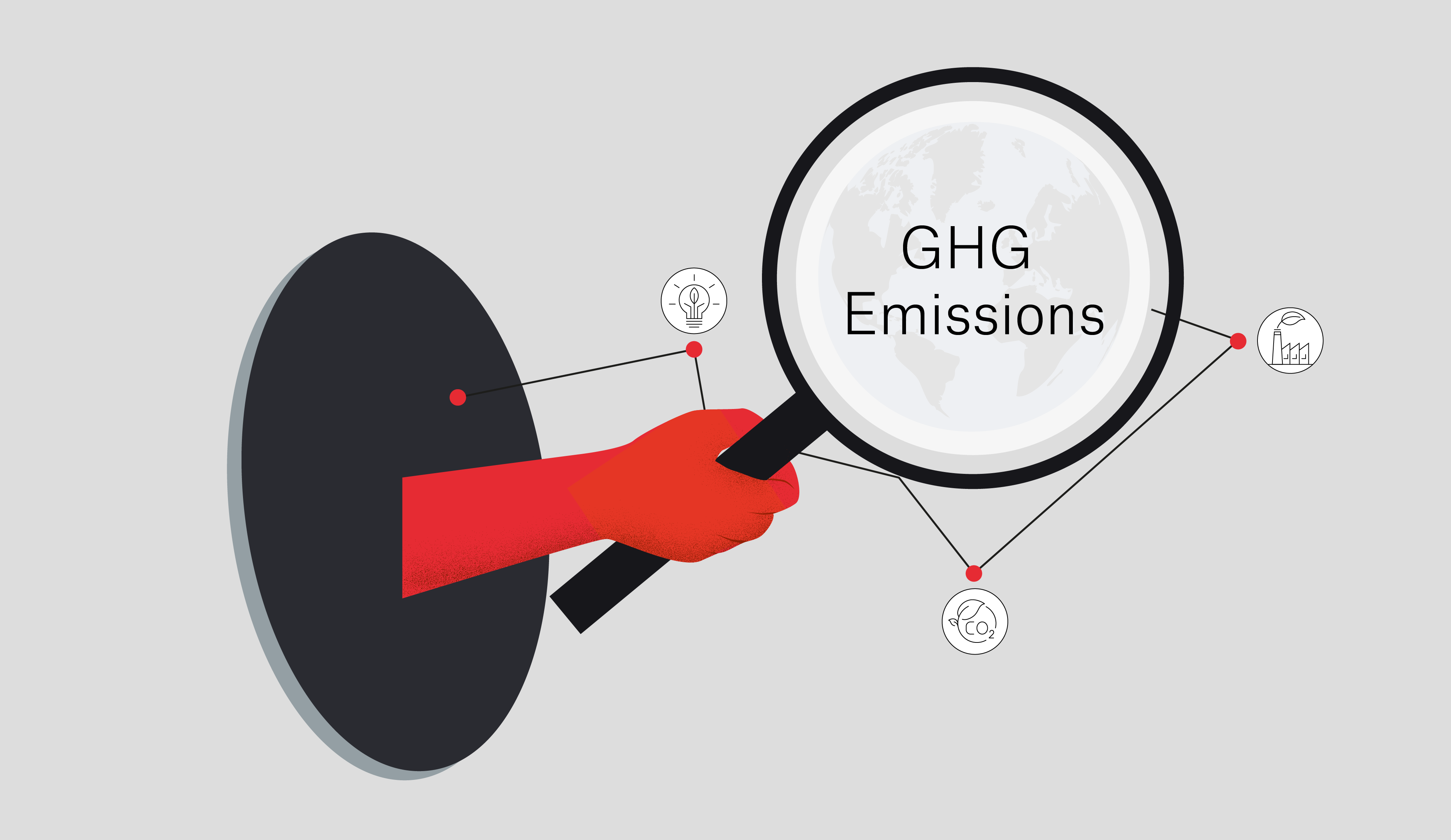
For more in-depth information on what scope 1, 2, and 3 emissions are and how to calculate them, visit our GHG emissions page.
Running emissions calculations
After pinpointing the emissions sources and collecting all the data needed, the next step is to calculate the organization’s emissions. For this, it’s important to know that GHGs are measured in tons or kilograms of carbon dioxide equivalent (tCO2e), and are calculated like this: Activity data x Emissions factor = GHG emission
Typically, activity data refers to energy consumed or waste generated. For example, this could be:
- The amount of fuel a car uses.
- The amount of electricity a building uses.
- Kilometers traveled by plane on a business trip.
Generating an emissions inventory report
Although generating an emissions report can seem complex, it is a vital part of quantifying and monitoring a company’s GHG emissions. An inventory report outlines an organization’s emissions by scope and activity and provides reliable data for estimating emissions and supporting regulatory measures. Notably, certain administrations, like the Canadian government, mandate that all facilities emitting over 10,000 tons of GHGs annually submit a report detailing their emissions - this includes buildings, equipment, on-site transportation, structures, and machinery.
Emissions inventories can be published on company websites, distributed to shareholders, and/or published on an emissions registry, such as the Climate Registry.
Inventory Reports Examples
Evaluating emissions reduction potential
Having sourced your activity data, calculated your emissions, and bundled them into a neat report, you should now be able to identify your greatest areas of opportunity to decarbonize. For example, you might notice that your fleet is responsible for 4% of your company-wide emissions while your buildings are emitting 19%. Considering your organization’s unique reality including its budget, organizational objectives, resources, and more, it will become clearer which emission activities hold the greatest reduction potential (in terms of speed and impact). Decide on 1-3 areas of focus and move on to the reduce phase.
Reducing GHG emissions
Emissions reduction is at the heart of what net zero aims to achieve. Companies that monitor their reduction progress and invest in the right emissions reduction projects and clean technology solutions can fast track their journey to net zero.
Comparing carbon reduction solutions
Based on your emissions reduction potential assessment, you can begin evaluating various carbon emissions reduction solutions. Start by establishing your company's evaluation criteria to help compare and properly assess the slew of different technologies, services, and products available.
In addition, to help you kick-start your research, here’s a list of solution types that you will want to look into:

Energy-efficient lighting
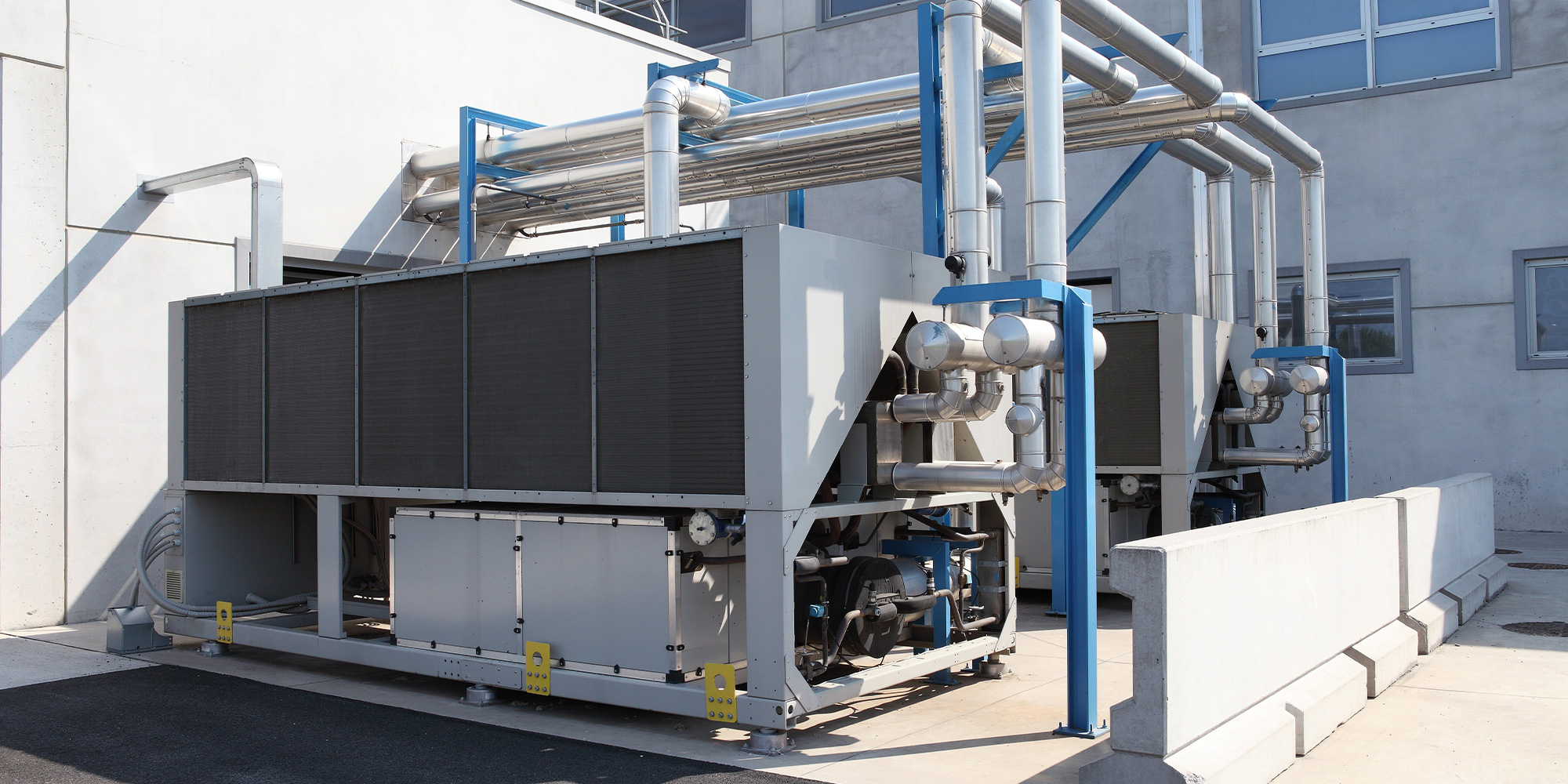
Heating and cooling optimization

Telecommuting

Waste reduction

Water conservation

Green procurement
Renewable energy solutions are also an increasingly popular and affordable option for companies looking for a long-term, cost-effective way to reduce their carbon footprint.
Here are a few examples of renewables that can help with the continued reduction of your building’s emissions:

Solar

Wind

Geothermal energy

Hydropower

Biomass energy
Implementing emissions reduction projects
Now that you’ve decided which reduction projects fit best, it’s time to put your project management skills to the test. Having a concrete, attainable, and viable plan that details how the solution will be deployed and how it aligns with your company’s overall sustainability strategy is key. Here are some high-level steps to consider:
- Establish your project scope: Objectives, partners and providers, internal stakeholders, timelines, resources, budgets, key KPIs, etc.
- Implicate key stakeholders & develop a plan together.
- Execute on the plan.
Tracking emissions reductions
While implementing emissions reduction methods is paramount, tracking the progress of these initiatives is also key to ensuring they are having the desired impact. Additionally, it helps companies understand the speed at which they are making progress, communicate the results of their efforts with confidence, and evaluate the efficacy and ROI of projects.
To track emissions reductions, businesses can use a variety of tools and methodologies, including carbon accounting software, sustainability consultants, third-party software solutions, emissions inventories, and GHG reporting frameworks such as the GHG Protocol. Ideally the results are displayed on a dashboard enabling sustainability teams to easily view their progress and be able to compare to their baseline.

Calculating your offsetting needs
Once you’ve figured out your carbon footprint and taken measures to reduce it, remaining carbon emissions can be offset. This requires calculating the number of tons of carbon your company continues to emit so you can purchase the equivalent amount through the carbon market.
Offsetting remaining emissions
Once a company has figured out their carbon footprint and taken measures to reduce it, their remaining carbon emissions can be offset. Carbon offsetting is the attempt to balance emissions by finding ways to reduce GHGs in the Earth’s atmosphere. This can be done by buying carbon offset credits, which can be put towards sustainability projects such as planting trees or conserving wetlands. Once the number of carbon credits purchased is of equal value to the carbon they emit, an organization is considered carbon neutral.
But reaching net zero (as opposed to carbon neutral, which is a broader, less regulated term) is about much more than offsetting. In fact, carbon offsets should be handled with care. To put the planet first and avoid accusations of greenwashing, companies need to be mindful of how, and how much, they use carbon offsets. Offsets should form the final part of an emissions reduction strategy, undertaken only after an organization has made every effort to lower its emissions. Additionally, businesses should also ensure that the offsets they choose are managed by reputable organizations that induce actual, meaningful environmental benefits.
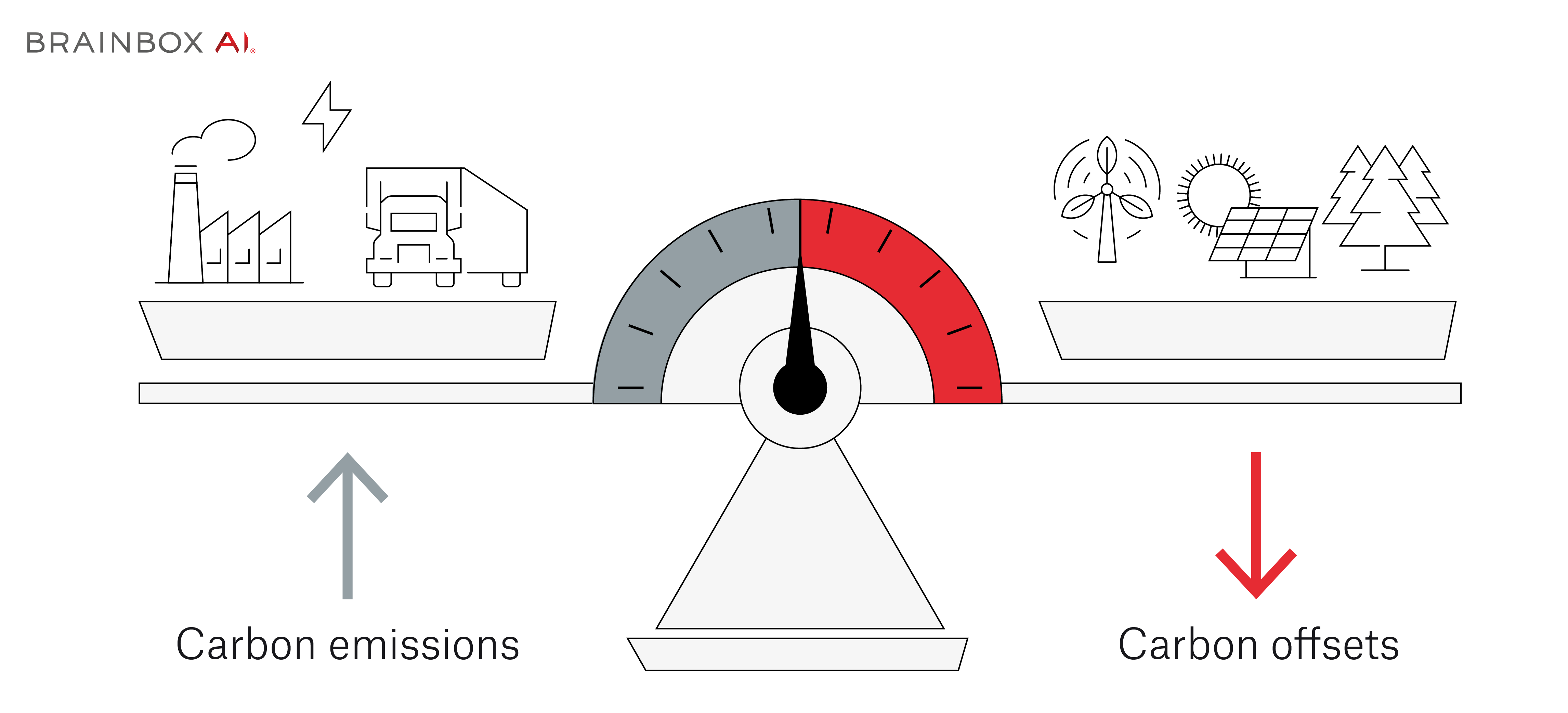
Identifying carbon offset projects
Carbon offset projects don’t just consist of planting trees. In fact, the voluntary carbon market is brimming with all kinds of initiatives, including nature-based solutions (focusing on afforestation, reforestation, and ecosystem restoration), community-based programs (such as water purification and off-grid electricity production), renewable energy projects (like wind power plants and solar photovoltaic farms), alternative fuel production (including sustainable aviation fuel), and engineered carbon removal initiatives (e.g., carbon capture and storage).
But with so many to choose from, how does a company select a carbon offset project that best aligns with its values and objectives? The answer lies in the consideration of several factors:
The permanence of a carbon offset project refers to how long the CO2 that’s removed or avoided will be kept out of the atmosphere. For example, a forestry project that plants trees to absorb carbon from the atmosphere can only be considered to deliver permanent carbon offsets if those trees continue to grow and sequester carbon. If they’re cut down prematurely, or are lost to natural disasters or disease, the carbon they sequestered will be released back into the atmosphere, and the carbon offsets generated by the project could be invalidated (which explains the rise of carbon credit insurance products).
Typically, 100 years is considered the benchmark that allows a project to brand itself as ‘permanent’, so good carbon offset projects generally assure that the carbon they sequester or avoid will remain out of the atmosphere for at least 100 years. They may also have clear and reliable measures in place, such as long-term contracts, insurance policies, and regular monitoring and verification to ensure their carbon offsets’ permanence.

Discover how companies can take responsibility for their carbon footprint and contribute to the fight against climate change with these 7 examples of carbon offsetting projects available on the voluntary carbon market.
Purchasing reputable offsets
With so many different offsetting projects out there, it can be difficult to determine which ones are legitimate and effective. This issue is especially worrisome considering that less than a third of projects aimed at preventing deforestation are of high quality. So, to help sort through the yays from the nays, we’ve come up with some helpful tips:
Third-party certification is one of the most important things to look for when evaluating a carbon offsetting project. Organizations such as the Verified Carbon Standard (VCS), the Climate Action Reserve (CAR), the Climate, Community & Biodiversity Standards (CCB), the American Carbon Registry (ACR), and the Gold Standard are all recognized as reputable certification programs. Offsetting projects that have their seal of approval are generally considered to be reliable.
Respected carbon credit rating firms such as Sylvera Ltd. and BeZero Carbon independently assess the likelihood of whether the credits issued by a carbon project have actually delivered on their claims. They’re useful in helping investors and buyers make informed decisions about their purchases, as they often have access to information that may not be publicly available, such as details about a project’s methodology, carbon reduction goals, and success track record. They can also provide information about the carbon credit market, including pricing and supply and demand trends.
There are a few important questions to ask when evaluating a project, such as: Has the project been successful in the past? Has it achieved its carbon reduction goals? Has it been able to maintain those reductions over time? Projects with longevity and a proven track record of success are more often than not a good choice.
It’s a good idea to do a little digging on the kind of methodology used by a project to achieve its carbon reductions. Is there any reputable research on the approach it uses? If they use technology, has that technology been proven to work?
It’s also important to consider the project's impact on the local community and environment. Look for projects that support sustainable agriculture, reforestation, or renewable energy and avoid displacing indigenous peoples or damage natural ecosystems.
Track the impact of your offsets
Having a dashboard that provides a visual representation of which carbon offsetting projects a company has invested in, their progress over time, and the impact they’re making is crucial for tracking offsetting investments and ensuring the reputability of each project. Moreover, it encourages transparency and engagement, turning investors into more active participants in the carbon market. A good dashboard should include:
- How much carbon has been offset through each project. This would be measured in tons of CO2 or CO2 equivalent and should be regularly updated to reflect the ongoing impact of the project.
- The environmental impact of each offsetting project, which can be illustrated in the equivalent number of trees planted or cars taken off the road. Tangible examples like these can help companies grasp the significance of their contribution. It could also include showcasing improvements in local air quality, biodiversity conservation, or community development initiatives.
- The social impact of each chosen project, including any benefits the project has brought to a local community, such as job creation, access to clean energy, or education programs.
.png)
Step 5: Disclose and report emissions
Disclosing your emissions reduction process and annual progress builds trust and transparency with shareholders and the public. Companies can do this through creating emissions reduction roadmaps and annual sustainability reports, which they then send to shareholders and/or publish on their website. Alternatively, they can disclose their progress through a platform like the Carbon Disclosure Project (CDP).
Disclosing processes to stakeholders
After validating their targets, strategies and emissions-reduction tactics and results - companies can communicate them to their stakeholders. This is an important step because stakeholders are increasingly requiring transparent and thoughtful communication when it comes to emissions reductions. However, this can be tricky as the vocabulary and concepts used in emissions reporting are still evolving. That’s why it’s important for companies to remain technically correct, accurate, and consistent with the latest climate science while remaining accessible to their stakeholders.
To help navigate these choppy waters, we’ve put together some guidelines on how companies can communicate a climate-related commitment while avoiding reputational risks:
Hiding behind scientific jargon could signal uncertainty about the meaning of some concepts. On the flip side, communicating in a way that’s clear and accessible to the general public demonstrates a knowledge of the field and increases stakeholders’ trust. Additionally, offering a relatable carbon equivalency comparison to emissions reductions achieved is a great way to help stakeholders visualize the impact a company is aiming for.
Avoid non-standardized terms such as ‘carbon-free’, ‘zero-carbon’, ‘climate neutral’, ‘carbon-negative’, and ‘carbon/climate positive’. These terms are not used in the scientific literature and could imply that a company doesn’t take emissions reduction seriously.
Instead, it’s best for businesses to stick to claims that illustrate and communicate their commitment to net zero emissions, such as ‘aligned with the net zero ambition’, ‘compatible with the global net zero target’, ‘path to net zero’, and ‘contributing to the net zero transition’.
For more inspiration on how to construct a report that discloses your company’s GHG emissions and targets, look to:
Reporting your progress to officials
The CDP (formerly the Carbon Disclosure Project) is an international, non-profit organization based in the UK, Japan, India, China, Germany, and the US. It provides a voluntary reporting framework used by companies to disclose environmental information to their stakeholders annually. Reporting through the CDP helps to legitimize a report and encourages industries to make emissions reporting the norm, driving disclosure and standardizing reporting.
However it’s shared, there are certain things that a report must include, such as information about a company’s effect on the environment, both beneficial and detrimental. It should also explain how the company contributes to communities or society through its policies and practices. Finally, the report should detail a company’s financial performance (such as its turnover or revenue) in addition to its investments in innovative methods, like clean technology or R&D programs. If some targets haven’t been met, it’s fine to admit it. In fact, stakeholders often appreciate it when companies highlight areas in which they can improve and list the obstacles faced and the potential challenges that lie ahead, as it demonstrates sincerity and determination to succeed.
Step 6: Share successes
To inform the public and congratulate and motivate employees, companies should consider sharing their emissions journey success stories via internal newsletters, press releases, their websites, and social media.
Celebrating net zero progress in an internal newsletter
It’s a good idea for a company to keep its employees abreast its net zero progress and successes through an internal newsletter. Doing so reinforces the idea that sustainability achievements are meaningful to the company. Additionally, employees will remain engaged, informed, and motivated to work together to achieve even deeper emissions reductions when they see their company is collaborating with other like-minded companies to address global issues.
The Cone Communications Millennial Employee Study found that 64% of Millennials consider a company’s social and environmental commitments when deciding where to work, and 83% would be more loyal to a company that helps them contribute to social and environmental issues.
Newsletters aren’t the only way a company can communicate its success to employees. Scorecards, dashboards, all-hands meetings, and webcasts can also have the same motivational, inspirational, and educational effect.
Communicating successes with the press
Press releases are a cornerstone of an effective communications program. They allow direct communication with the public while revealing a company’s perspective and facilitating publicity. So how can companies use press releases to effectively tell their net zero story?
A lot of people read press releases, so companies should be sure to address their customers, employees, and partners.
A press release shouldn’t be just a one-off campaign timed to align with Earth Day. Instead, businesses would do best to weave their emissions reduction story throughout the year, showing they’re aware that sustainability is not just a passing trend.
Companies shouldn’t just look to successful ESG initiatives as inspiration for building their press releases. They can learn a lot from those who failed, lied, or remained silent.
This signals to journalists that a company is serious about its ESG responsibilities and helps the media remember your message and where your company stands on sustainability.
Targeting some of the ESG content to financial journalists or investment professionals, showcasing how and why a company’s ESG initiatives will be financially beneficial.
Adding ESG-related keywords and tags to press releases increases their visibility.
Using a press release distribution service that specializes in targeting ESG media outlets and journalists.
- Optimises the HVAC system you already have.
- No expensive retrofitting, no sensors required.
- Minimal initial investment.

In addition to a press release, a company should make sure to also publish information on its website detailing the progress it’s made so far on its net zero journey. This will help support the announcements made in the media and it will make it easier for journalists to source extra information.
Press Release Examples



